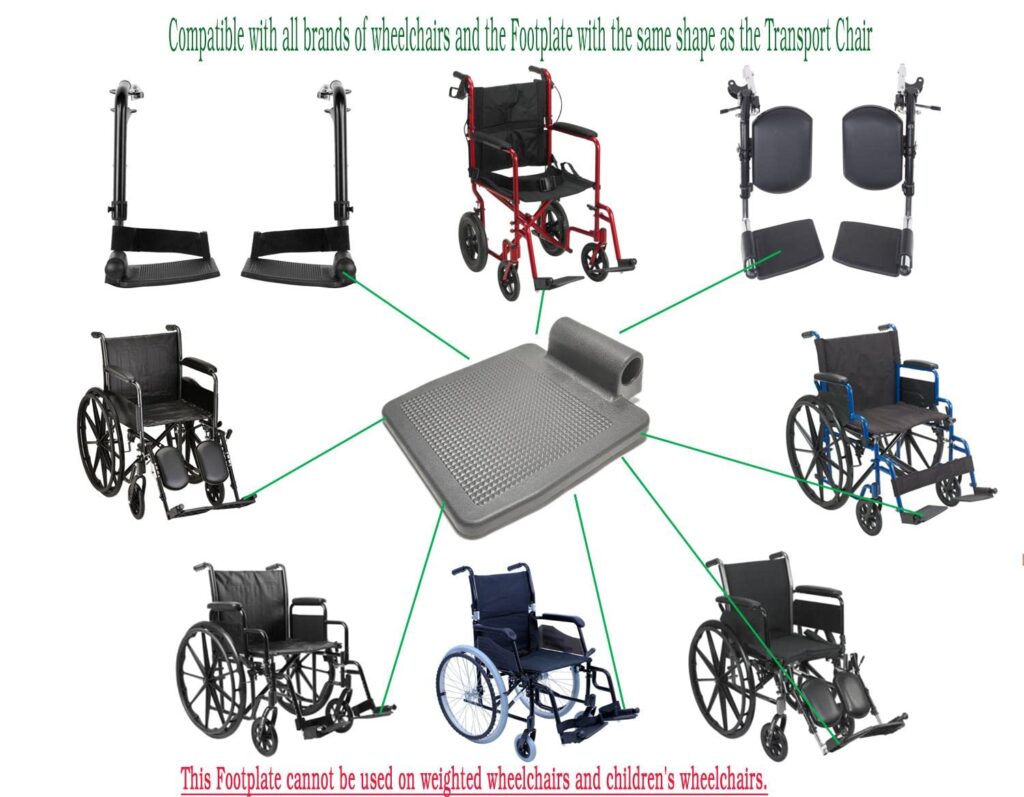A wheelchair is a mobilized form of the chair using 2 or more wheels, a footrest and an armrest usually cushioned. It is used when walking is difficult or impossible to do due to illnesses, injury, disabilities, or age-related health conditions.
Wheelchairs come in a wide variety of formats to meet the specific needs of their users. They may include specialized seating adaptions, and individualized controls, and may be specific to particular activities, as with sports wheelchairs and beach wheelchairs. The most widely recognized distinction is between motorized wheelchairs, where propulsion is provided by batteries and electric motors, and manual wheelchairs, where the propulsive force is provided either by the wheelchair user or occupant pushing the wheelchair by hand (self-propelled), by an attendant pushing from the rear using the handle(s), or by an attendant pushing from the side use a handle attachment.
History:
The earliest records of wheeled furniture include an inscription on a stone slate found in China and a depiction of a child’s bed on a Greek vase, both dating back to between the 6th and 5th century BC. The first records of wheeled seats used for transporting disabled people date to three centuries later in China; the Chinese utilized early wheelbarrows to move both people and heavy objects. A distinction between the two functions did not emerge until around AD 525 when Chinese art started to depict wheeled chairs specifically designed for carrying people.

Although Europeans eventually developed a similar design, this method of transportation did not exist until 1595[6] when an unknown inventor from Spain built one for King Phillip II. Although it was an elaborate chair having both armrests and leg rests, the design still had shortcomings since it did not feature an efficient propulsion mechanism and thus required assistance to propel it. This makes the design more comparable to a modern-day highchair or portable throne for the wealthy than to a modern-day wheelchair for disabled people.

Sir Thomas Fairfax, the Parliamentarian commander-in-chief, used a self-propelled wheelchair in the final years of his life due to the numerous injuries he had sustained during the English Civil War. The wheelchair of Thomas Fairfax is currently on display at the National Civil War Centre in Newark-on-Trent.
The invalid carriage or Bath chair brought the technology into more common use from around 1760.
In 1887, wheelchairs (“rolling chairs”) were introduced to Atlantic City so invalid tourists could rent them to enjoy the Boardwalk. Soon, many healthy tourists also rented the decorated “rolling chairs” and servants to push them as a show of decadence and treatment they could never experience at home.
Modern wheelchair
In 1933 Harry C. Jennings Sr. and his disabled friend Herbert Everest, both mechanical engineers, invented the first lightweight, steel, folding, portable wheelchair.[11] Everest had previously broken his back in a mining accident. Everest and Jennings saw the business potential of the invention and went on to become the first mass-market manufacturers of wheelchairs. Their “X-brace” design[12] is still in common use, albeit with updated materials and other improvements. The X-brace idea came to Jennings from the men’s folding “camp chairs/stools”, rotated 90 degrees, used in the outdoors and at the mines

Types
There are a wide variety of types of wheelchairs, differing by propulsion method, mechanisms of control, and technology used. Some wheelchairs are designed for general everyday use, while others are tailored for specific activities or to meet particular access needs. Innovation within the wheelchair industry is relatively common, but many innovations ultimately fall by the wayside, either from over-specialization or from failing to come to market at an accessible price point. The iBOT is perhaps the best-known example of this in recent years.
Manual self-propelled wheelchair
This section does not cite any sources. Please help improve this section by adding citations to reliable sources. Unsourced material may be challenged and removed. (November 2020) (Learn how and when to remove this message)
This section’s neutrality is under dispute. Please refer to the discussion on the talk page for relevant details. The message should not be removed until consensus is reached on the appropriate action. (November 2020) (Learn how and when to remove this message)

Folding chairs and stackable rigid chairs for visitors in NÄL Hospital, Sweden
A self-propelled manual wheelchair incorporates a frame, seat, one or two footplates (footrests), and four wheels: usually two caster wheels at the front and two large wheels at the back. There will generally also be a separate seat cushion. The larger rear wheels usually have push-rims of slightly smaller diameter projecting just beyond the tire; these allow the user to maneuver the chair by pushing on them without requiring them to grasp the tires.
Asad surgical shop
we all so provide home health care services in Rawalpindi & islamabad
Manual wheelchairs generally have brakes that bear on the tires of the rear wheels, however, these are solely parking brakes and in-motion braking is provided by the user’s palms bearing directly on the push-rims. As this causes friction and heat build-up, particularly on long downslopes, many wheelchair users will choose to wear padded wheelchair gloves. Manual wheelchairs often have two push handles at the upper rear of the frame to allow for manual propulsion by a second person, however, many active wheelchair users will remove these to prevent unwanted pushing from people who believe they are being helpful.
Everyday manual wheelchairs come in two major varieties, folding or rigid. Folding chairs are generally low-end designs,[13] whose predominant advantage is being able to fold, generally by bringing the two sides together. This is an advantage for people who need to store

wheelchair Buildings
Adapting the built environment to make it more accessible to wheelchair users is one of the key campaigns of disability rights movements and local equality legislation such as the Americans with Disabilities Act of 1990 (ADA). The social model of disability defines ‘disability’ as the discrimination experienced by people with impairments as a result of the failure of society to provide the adaptions needed for them to participate in society as equals. This includes both physical adaptions of the built environment and adaption of organizational and social structures and attitudes. A core principle of access is universal design – that all people regardless of disability are entitled to equal access to all parts of society like public transportation and buildings. A wheelchair user is less disabled in an environment without stairs.
Area of services
Wheel Chair For Sale & Rent in islamabad & Rawalpindi
All Medical equipment for sale & Rent at home in Rawalpindi & Islamabad Aspirator Suction machine for sale & Rent in Saddar, DHA Phase 1, DHA Phase 2, DHA Phase 3, DHA Phase 4, DHA Phase 5, DHA Phase 6, Bahria town phase 1, Bahria town phase 2, Bahria town phase 3, Bahria town phase 4, Bahria town phase 5, Bahria town phase 6, Bahria town phase 7, Bahria town phase 8, Islamabad, B17, F11, G11, G10, G9, i8, Askari 11, Ghauri town, and all areas of twins cities.
Cardiac Monitor Oxygen cylinder | Hospital bed | ICU Bed | Bed on casters | 4 sections bed | Electric bed | Reclining bed | Cardia Monitor| Trendelenburg bed | Hospital bed mattress | Medical bed | Foam mattress bed | Anti-decubitus mattress | Fixed-height bed | Medical chair | Bedside cabinet on casters | Healthcare facility armchair | Bedside cabinet with compartments | Shell chair | Over-bed table on casters | Home care bed | Suction Machine.
